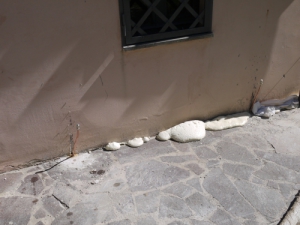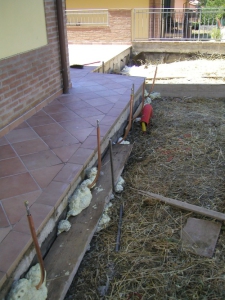 The “Plus -System” injection system, with foaming polyurethane resin, is another consolidation system in addition to the innovative patented “Minipali Geo-System®”.
The “Plus -System” injection system, with foaming polyurethane resin, is another consolidation system in addition to the innovative patented “Minipali Geo-System®”.
This system offers the possibility to solve rapidly, permanently and noninvasively, problems linked to foundation settlements with cracking on the walls.
In the last few years the grounds consolidation with resins had worked alongside traditional technologies by virtue of lower costs, commissioning timing strongly reduced and possibility to work inside buildings without causing any harm.
The numerous worksites performed with this methodology show that with few working hours, land below the bottom floor instantly increases its geotechnical characteristics depending on the type of resin applied.
With this methodology the resins expand what is necessary to fill the voids of the soil, giving high compression strength; this represents a difference compare to other systems, which may cause additional damages to walls and floors.
Causes of subsidences
The appearance of damages is generally linked to the following:
-inadequate foundations;
-soils with poor bearing capacity;
-presence of clay soils with seasonal variations of water content (expansion/contraction);
-lowering/rise of natural groundwater level or induced by pumping;
-water flows under the foundations with run-off phenomena;
-lithological diversity in the area of the building settling;
-presence of plants immediately close to the building.
“Plus-System” method
 After carefully checking the presence of underground line services (gas, water, etc), a number of small diameter holes are performed at the foundation at a specific depth depending on the type of soil and foundation; a copper tube connected in the head to a gun (in communication with the general compressor) in inserted into the hole. Then, the appropriate resin is injected at high pressure. This stage is particularly delicate and it is usually monitored by technicians with laser instruments, which allows monitoring the soil consolidation process at any time.
After carefully checking the presence of underground line services (gas, water, etc), a number of small diameter holes are performed at the foundation at a specific depth depending on the type of soil and foundation; a copper tube connected in the head to a gun (in communication with the general compressor) in inserted into the hole. Then, the appropriate resin is injected at high pressure. This stage is particularly delicate and it is usually monitored by technicians with laser instruments, which allows monitoring the soil consolidation process at any time.
In a few hours the resin reaches the final expansion and the ground immediately adopts new geotechnical characteristics with a compressive strength, greater than that of the pre-injection phase.
The effectiveness of the resin is supreme in granular soils, but progressively decreases in the range of clays (fine particles).
The single-component and bi-component polyurethane resins used are specially designed and formulated in order to solve all issues related to the consolidation of any kind of soils.
The “Plus Series” bi-component and “Soil Series” single-component resins have been designed and made in respect of the ecosystem and environmental safety; in fact, after hardening they assume simple inert characteristics without creating pollution effects, and don’t change their behavior even if they are used in the presence of water.
THE RESULT
Control tools
In order to double-check the effectiveness of the intervention, we can use either dynamic penetration tests adjacent to the foundation, before and after operating, or sophisticated geophysical survey techniques (GPR); both techniques permit to show a section of the geometry of injected materials, providing lateral extension and depth.
During the expansion of the resin, lifting of structures is continuously controlled by precision laser pointers and electronic crack meter.
Microcements and/or colloidal nano-silica can be used in very fine soils, as an alternative to polyurethane resins.
Colloidal nano-silica is a product entirely mineral composed, due to the crystalline display of atoms in nano-silica suspension. Reduced viscosity (5cP), compare to water (1cP), allows penetration in fine and non-cohesive soils (permeability up to 10^-5 m/s). Compressive strengths reached by this product go up to 1Mpa, tending to grow slowly over the time.
Instead, microcements are a mixture of ultrafine cement and specific additives that let them penetrate the joints, slots and porosity of very fine soils. They are ideal for sealing the water of the aquifer; in addition to the strengthening of soil, they can also be used for containing the excavation face, ensuring the containment of water from the rock mass or injected soil.
Microcements at 3gg reach a compressive strength equal to 10-15 Mpa.
